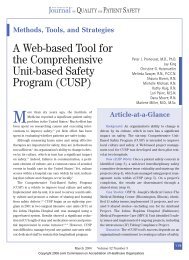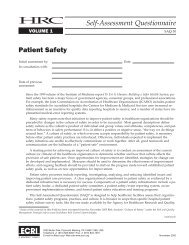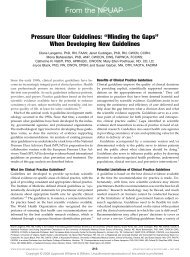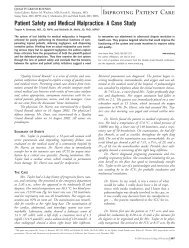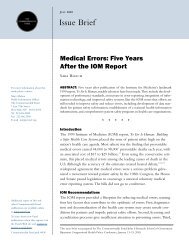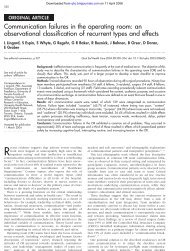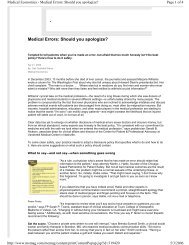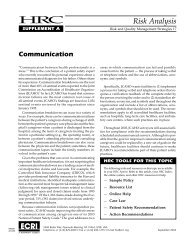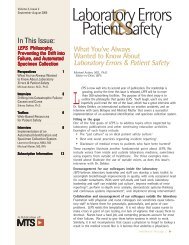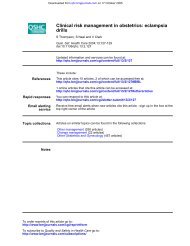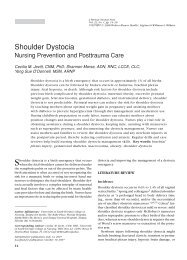Chain of Command - MCIC Vermont Patient Safety Documents
Chain of Command - MCIC Vermont Patient Safety Documents
Chain of Command - MCIC Vermont Patient Safety Documents
You also want an ePaper? Increase the reach of your titles
YUMPU automatically turns print PDFs into web optimized ePapers that Google loves.
2 Healthcare Risk Control<br />
Failure to Pursue Physician Bedside Evaluation<br />
A 70-year-old female patient with asthma who was<br />
hospitalized for major depression on a psychiatric unit<br />
developed progressive respiratory difficulties leading<br />
to acute respiratory failure that necessitated intubation<br />
and admission to the intensive care unit (ICU). She ultimately<br />
recovered after several weeks <strong>of</strong> hospitalization<br />
and rehabilitation following discharge.<br />
Allegations in a liability suit brought by the patient included<br />
failure to monitor, failure to timely contact the<br />
physician, and failure to take aggressive action. The<br />
case was settled before trial by the hospital and the physician.<br />
The sequence <strong>of</strong> events is summarized below.<br />
• At 7 p.m. on the second day <strong>of</strong> her psychiatric admission,<br />
the patient developed shortness <strong>of</strong> breath and<br />
expiratory wheezing, unrelieved by her Proventil inhaler.<br />
Also, mild edema <strong>of</strong> the right ankle had increased<br />
significantly from earlier in the day.<br />
• At 7:30 p.m., the covering medical physician was<br />
notified and the patient was treated with a diuretic<br />
and a nebulizer, which were ineffective.<br />
• At 10:30 p.m., oxygen was applied and Ativan was<br />
administered, which were also ineffective, as the<br />
patient stated that she could not breathe.<br />
• At 11:30 p.m., the physician was notified and arterial<br />
blood gases (ABGs) were ordered, as were additional<br />
respiratory treatments, and then repeat<br />
ABGs. Initial ABGs showed hypercarbia and hypoxia,<br />
but following the respiratory treatments, the<br />
levels improved slightly.<br />
• Although tachypnic, the patient calmed down and<br />
rested between 1 and 3 a.m.<br />
• At 3:30 a.m., the patient again experienced respiratory<br />
distress and the physician was again notified.<br />
Sketchy documentation and missing records make<br />
it difficult to ascertain what, if any, interventions<br />
took place until another nursing entry an hour later,<br />
at 4:30 a.m., when the patient was described as being<br />
diaphoretic and having increased respiratory<br />
distress.<br />
• At 5:30 a.m., the physician was called again. The patient<br />
was taken to the emergency department where<br />
she was intubated during cardiopulmonary arrest,<br />
stabilized, and then transferred to the ICU.<br />
HRC Commentary: When the patient’s condition was<br />
clearly becoming worse and the physician did not come<br />
in to evaluate her, the psychiatric unit nurses and staff<br />
had a duty to aggressively pursue bedside medical<br />
evaluation. Additional calls to the physician were warranted<br />
in this case, as was utilization <strong>of</strong> the chain <strong>of</strong> command<br />
as necessary to obtain medical examination by a<br />
physician. Instead, the patient was allowed to remain in<br />
distress for several hours, which delayed appropriate<br />
management <strong>of</strong> her respiratory distress. The physician<br />
also under treated the patient at the time <strong>of</strong> the second<br />
notification at 11:30 a.m., when drug therapy (steroids,<br />
inhaled beta agonists, etc.) was indicated.<br />
• provide for patient advocacy in the institution,<br />
• support patient safety by maintaining the standard <strong>of</strong><br />
care, and<br />
• support risk management by mitigating liability<br />
exposures.<br />
<strong>Chain</strong> <strong>of</strong> command should be used to affect a necessary<br />
intervention for a patient’s well-being if the responsible<br />
provider is delayed or is unable or unwilling to<br />
intervene. 5 <strong>Chain</strong> <strong>of</strong> command should also be used when<br />
the provider’s response or intervention is inappropriate<br />
to the degree <strong>of</strong> urgency dictated by the patient’s condition<br />
or when treatment is ineffective over time and the<br />
provider does not present to personally examine the patient.<br />
The scenario described in “Failure to Pursue Physician<br />
Bedside Evaluation” outlines the sequence <strong>of</strong><br />
events in one case that demonstrates failure to use the<br />
chain <strong>of</strong> command.<br />
Communication, Culture, and Role<br />
Conflict<br />
<strong>Chain</strong>-<strong>of</strong>-command policies may be unused or underused<br />
for many reasons, including nursing staff’s reluctance<br />
for fear <strong>of</strong> causing trouble, a fear <strong>of</strong> the consequences<br />
<strong>of</strong> going over someone’s head, or a lack <strong>of</strong> knowledge and<br />
understanding <strong>of</strong> how to use the policies. 6 The involved<br />
caregivers should make the initial attempts to settle patient<br />
care conflicts through direct communication. But at<br />
times, this is more easily said than done.<br />
Difficulties in communication and collaboration between<br />
physicians and nurses have long been documented<br />
7 and continue to be the subject <strong>of</strong> much study and<br />
debate. 8 Communication problems can plague physician-nurse<br />
relationships and negatively affect patient<br />
care. In a study <strong>of</strong> timely treatment <strong>of</strong> lower respiratory<br />
infections in nursing home residents, delays in treatment<br />
©2004 ECRI. May be reproduced by member institution only for distribution within its own facility.



